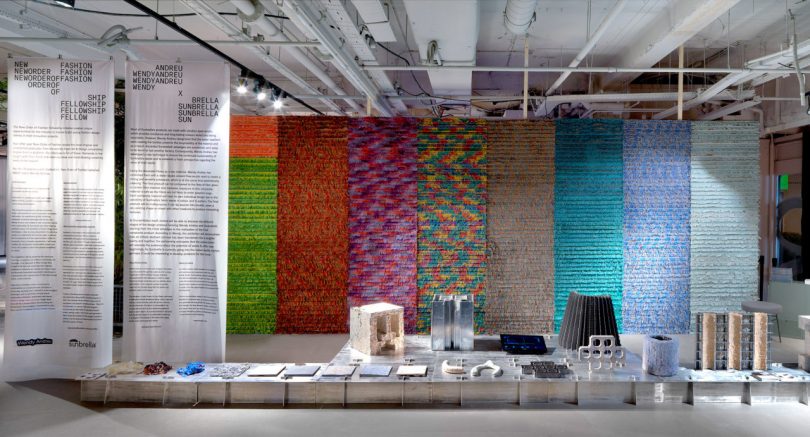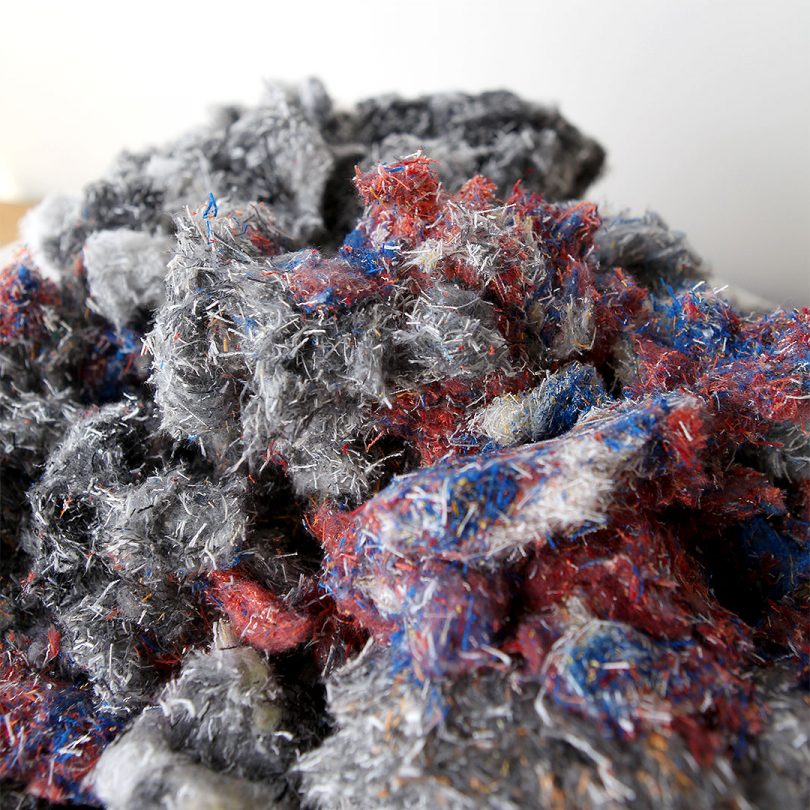The circular economy is a proposed alternative to our traditional ‘take, make, waste’ model of production and consumption – one that offers hope in the face of environmental catastrophes from climate change to ocean plastic. Designing out waste and pollution, keeping materials and products in use and regenerating our natural environment are so important to contemporary design that we wanted to create a dedicated space for the projects bringing these ideas to life. Circular by Design, a fortnightly column by longtime contributor Katie Treggiden, will start by exploring the potential of waste as a valuable new raw material.
Paris-based designer-maker Wendy Andreu uses materials as a means of communication, experimenting to find surprising outcomes that can be translated into functional design proposals. She collaborated with performance fabric manufacturer Sunbrella to create a new innovative material from its waste selvedges – the woven or knitted edges of textile rolls that are usually discarded.
Tell me a little bit about your childhood, education, and background in terms of how you first became interested in creativity, design, and sustainability.
I was born in a rural area of the South West of France. Growing up with a father who was a technician in an aeronautic factory and a mother who was an insurance agent, I felt that my perspective there was quite narrow. I wanted to explore art and culture, so at the age of 14, I decided to study applied arts at a boarding school in the Basque country. There, I discovered the potential of the creative industries and knew what I wanted to do with my life. At 17, I moved to Paris to study metal craftsmanship at the Ecole Boulle, gaining a traditional and technical education. In 2012, I was accepted into the Design Academy Eindhoven. There, I was able to be a craftsperson as well as a designer – making and thinking all at the same time. I was really inspired by that approach and pushed out of my comfort zone to try things I would never have thought about trying. I graduated cum laude in 2016 with a collection of rainproof accessories made with a textile I had developed myself – and won the Dorothy Waxman textile prize and the public prize for fashion accessories at the Villa Noailles, Hyères.
How would you describe your Solid Selvedges collaboration with Sunbrella
Sunbrella makes performance fabrics for awning and shade structures, as well as marine canvas and upholstery for both outdoor and indoor applications. I was introduced to them by The New Order of Fashion [formerly Modebelofte – a platform for interdisciplinary collaborations with emerging fashion talents] with the idea of sustainability and tackling waste in mind. Most of Sunbrella’s products are made with solution-dyed acrylic, a high-quality textile fiber that provides long-lasting colors and strong products. During production, the selvedges (the edge of a fabric – usually woven or knit so that it will not fray) of the textile rolls are discarded. Focusing on these selvedges, I created a composite material in which the discarded fiber from Sunbrella could become one of the raw materials.
What inspired this project?
I experiment with materials to understand their potential – I like to understand traditional techniques and then re-think how things are made. I am also very interested in small scale craftsmanship and I am very proud to produce only a few pieces each year, working with European suppliers and manufacturers. Sustainability is linked to how we produce goods – and this is a question that I ask myself every day. Which design choice will lead to the least waste? Which choice will create less pollution? By carefully thinking through all the options, applying knowledge and creativity, the best design outcomes can be reached. This particular research project was inspired by the material itself. The acrylic waste, once coated with a resin to make it waterproof, cannot be recycled, so I had to think about other ways to step in. I went to Lille to visit the Sunbrella factory and to understand the processes. I researched acrylic and acrylic properties. I spoke with people from the factory and try to understand the context and how this waste product be related to the same context? I was also inspired by carbon and glass fiber techniques, in which fibers are used to reinforce a resin – and I decided to give the Sunbrella fibers the same function. I didn’t want to use harmful transformation processes such as burning or melting, or use hazardous resins such as polyester or epoxy.
What waste materials are the products made from, how did you select that particular material, and how do you source it?
I limited myself to the selvedge. By focusing on a single type of waste, I was able to be efficient and precise in my research. Each waste stream has its own potential that can lead to its very own beauty. The key is to understand where the beauty stands, dig it out and translate it into a tangible proposal. Then waste becomes valuable. The Lille production site generates 70 tons of selvedges waste every year, so there is huge potential.
When did you first become interested in using waste as raw material and what motivated this decision?
I designed my first piece with waste as a raw material in 2018 in response to a brief from Laura Houseley and James Shaw to make a textile piece using plastic for the Plasticscene Exhibition they curated for LDF the same year. I contacted my rope suppliers, the Société Choletaise de Fabrication, and asked them if they could send me discarded polyester rope. I received a random selection of hiking boot laces in a diversity of colors and patterns. I bonded these laces together with a black polyurethane paste in order to create a rug. The use of waste always involves the randomness of the leftover and it was interesting to make a piece without being totally in control of the colors – I like to take advantage of this randomness as it always generates unique objects.
What processes does the waste material have to undergo to become the finished fabric?
The Sunbrella selvedges are cut into tiny squares and then reduced to fine fibers. These fibers are mixed with water-based, solvent-free acrylic resin to create a hard material. The acrylic fiber makes the material stronger by bonding with the acrylic paste – and gives the plaster-like resin a color. The resin can be poured into molds or coated onto existing forms. This process transforms soft and colorful textiles into a stone-like building material, extending the spectrum into which the Sunbrella textile can be applied. At this stage, the project is only a promising research project, but I would like to be able to push it further.
How did you feel the first time you saw the transformation from waste material to product/prototype?
I work step by step, so the first tests were small, flat, samples. They were promising as I liked their materiality and tactility. I was very keen to create molds as they allow production without waste. I designed molds in aluminum and kept the objects interesting, light and yet very abstract so people could envision many more possibilities with them. Everything worked out pretty well and I was very happy with the result. You can see and guess the fibers stuck in the resin – and some details of the colored fibers are quite beautiful as they layer in a very lively composition. It is very important to me that the designs I make are appealing and desirable.
What happens to the products at the end of their lives? Can they go back into the circular economy again?
Neither of the materials (the original waste selvedge fibers nor the resin) is biodegradable and neither can be recycled, unfortunately. However, I have turned a waste material which couldn’t be recycled into something that is made to last and won’t be destroyed easily, extending its lifespan.
How have people reacted to this project?
People were intrigued first and curious about the material – lots of people expected it to be much lighter than it is. It is interesting to notice the new aesthetics that can be created with waste – people could envision them for retail environments, interior design, objects, furniture… They also were craving to touch the material as it is quite tactile. I think these type of alternative materials are increasingly sought after as people become more and more interested in working with them. Companies big and small – be they manufacturers, retailers, or the fashion industry as a whole – will soon have no other choice but to think about their environmental footprint. Customers, then politics and laws, will push industries in this direction. In my opinion, the companies who don’t respond will decline fast.
How do you feel opinions towards waste as a raw material are changing?
The idea is still disgusting for many people, including designers – waste and garbage are not the most appealing things in the world. However, with a little bit more education on materials and how things are made, perhaps people can better envision products made from waste. It is the role of designers to create positive interpretations of waste or discarded products in order to create beauty. I wish that more industries and manufacturers would be open-minded enough to hire designers not only for their main objects, but also to think about their waste. It could be profitable for them on an ecological and economical basis. It is important to create appealing products and not make too much of the “trash aesthetic” that is often associated with waste.
What do you think the future holds for waste as a raw material?
Waste is the result of the Anthropocene. The amount of garbage is growing while available natural resources are becoming more and more scarce. Waste barely exists in the natural environment as nature works in cycles. Each element has a role and the outputs of one process simply become the inputs for another. It is easy to foresee a future in which waste becomes a raw material and an available resource. Waste is one of the materials of the future. In France a new law against overproduction comes into force next year: manufacturers and companies won’t be able to throw away or destroy their unsold products anymore. These products will need to be either donated or recycled. These very clean waste streams might be the beginning of a new perspective for materiality and production.
from WordPress https://connorrenwickblog.wordpress.com/2020/07/07/circular-by-design-wendy-andreu-turns-selvedges-into-innovative-new-material/














No comments:
Post a Comment